|
|||||
FlyingRC.net is a
Veteran-Owned site.

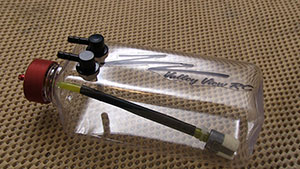 |
| Valley View RC has some new thinking in their new gas tanks and we put one to the test in a plane that the week before was having dead stick "issues". Click image to enlarge |
Valley View RC Three-Line Gas Tanks
Advanced materials mean lighter, better functioning tanks
Text, photos and video by Tom Hintz
Flight video by Clark Ponthier
Posted - 9-27-2017
Every time I think RC gas tank technology has gone about as far as it can, somebody comes up with a new idea or new material and tank technology takes another step forward. Of course, refining something like an RC gas tank takes some innovation and developmental expense. The folks at Valley View RC have been in the RC hobby for a long time and have a sound idea of what can help their customers fly better and safer. The gas tank shown here is the newest Valley View RC offering so we wanted to see how well it works.
The Basics
The Valley View Gas Tank is comprised of a clear plastic bottle, made from material that is a bit thicker than many clear tanks. The increased thickness provides more durability but surprisingly little in the way of added weight. We are talking additional grams here so if your plane can’t handle that, you need a bigger engine. I will happily add this bit of weight to add more durability any day.
The Valley View Gas Tanks are available in two and three-line configurations. I am a firm believer in the three-line system so that is the model we are reviewing. However, since the only difference is the extra (fill) line in the three-line version there should be no difference in performance between them.
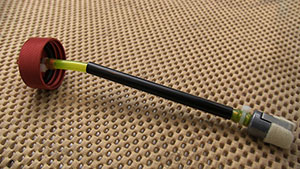 |
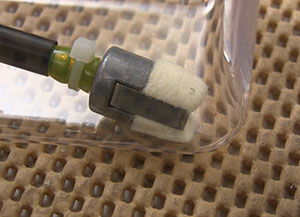 |
| Probably the most radical thinking is in the sleeve (left) over the pickup line that prevents it from getting tucked forward in a hard landing or getting bounced around to and from the field. The filter on the clunk (right) adds another level protection against junk in the carb. Click images to enlarge |
|
The Valley View Gas Tanks have a nicely made, screw-on cap with a single feed line for the carburetor. This cap is snug and seals against a large O-ring that makes a leak hard to imagine if the cap is screwed on firmly.
The internal components are largely made from gas-proof plastic but like the tank itself, thicker material has been used for strength and to allow larger passages/tubing to allow more fuel in the line. This is a crucial difference in my estimation. Having more fuel in the line to the carb does wonders for curing those little skips and brief RPM sags when smaller lines can starve the carb for sufficient fuel even for an instant during some high-G maneuvers.
The feed line is fitted with Tygon fuel line, regarded by many to be the best you can get. At the end of that line is a felt-equipped clunk weight that filters the fuel as it is drawn towards the carb. This type of clunk seems able to empty the tank more effectively than the simple weighted clunks. I’m not sure why that is but when I have run tanks with the felt-equipped clunks dry, they really were empty.
Another great idea is a re-enforcement tube that is installed over the pickup line between the cap and the clunk. The tubing is reasonably rigid and designed to prevent the clunk from folding forward during a rough landing or small crash. The tubing is short enough to allow the clunk to have a full range of motion in all directions except forward.
Installing the Valley View Gas Tank is no different than with other tanks except for needing to use larger fuel line, as we should be anyway. The fittings are not designed for easy installation of the line, they are meant to keep the line secure after it is installed. The fit is tight enough that it will help a bunch to warm the end of the fuel line up to make it more pliable. Then it slips over the fittings more easily.
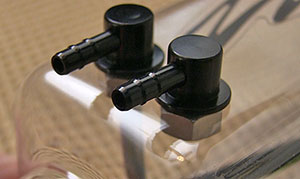 |
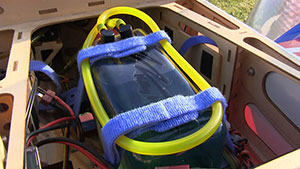 |
| The fittings (left) have large bases that provide exceptional sealing. Mike had no trouble installing the Valley View Gas Tank (right) in his Edge. Click images to enlarge |
|
In the Air
One of my regular flying buddies, Mike Basmajian, agreed to put the Valley View Gas Tank in his Extreme Flight, 35cc Edge 540. The gas tank in his plane was getting old and he had been having some motor issues, including a couple unexplained deadsticks. Mike reports that the installation was simple other than having to go to larger fuel line which we knew up front.
Starting the DA35 for the first time with the new tank (empty lines) went much quicker than I expected. Once it fired Mike decided no further adjusting was needed so he took it to the flight line. Mike flies this plane a lot and I know he likes it so it surprised me a little that he didn’t fly around a little to see how happy the motor was.
From the time Mike nailed the gas the DA35 never missed a lick. Mike took it vertical and proceeded to put the Edge in every odd attitude he could think of to see if the engine would starve for fuel or at least sound differently. Nope, the DA35 just kept perking along without a miss or stumble.
Mike is good at high alpha flying and is not afraid to do it down low. Here again, I expected a bit of restraint while he felt out the new tank but he apparently felt fine with the engine and was doing his really high angle slow flight way less than one mistake high so if the tank/engine balked, the Edge was in big trouble. But, Mike was right and throughout the flight getting fuel to the engine was not an issue.
The mysterious engine irregularities with the old tank were gone during the maiden (for the Valley View Gas Tank) and the rest of his flights that day. Because nothing on the engine was changed it is obvious that the old tank just wasn’t up to it anymore. I’d like to say I have the inside scoop on just what was wrong but I can say that with the Valley View Gas Tank, Mikes’ Edge is once again very happy and that makes Mike happy as well.
Conclusions
Video Tour |
Valley View RC has a reputation for bringing good quality components to the hobby and their Valley View Gas Tank follows that tradition. I like everything about this tank from the materials to the overall design. Even the fill and vent fittings in the top of the tank are oversized which gives them a larger sealing area to insure trouble-free flying.
Another important point is that the Valley View Gas Tank in the 16oz, 24oz and 32oz sizes sell for $24.95! (9-7-2017) It’s not often these days that we can find a top-shelf product in this hobby for a surprisingly reasonable cost. The fuel tank is a crucial part of the system that keeps our planes flying as expected. If (or when) you become concerned with your fuel system, remember the Valley View Gas Tanks. Installing one of these tanks could be the most economical thing you do for your plane over the long haul.
Visit the Valley View RC Gas Tank page – Click Here
Have a comment on this Review? –Email Me!
All Flyingrc.net written, photographic and drawn materials are property of and copyright by Tom Hintz and Flyingrc.net 2013-2020 Materials cannot be used in any way without the prior written permission of the owner.
Privacy Statement


